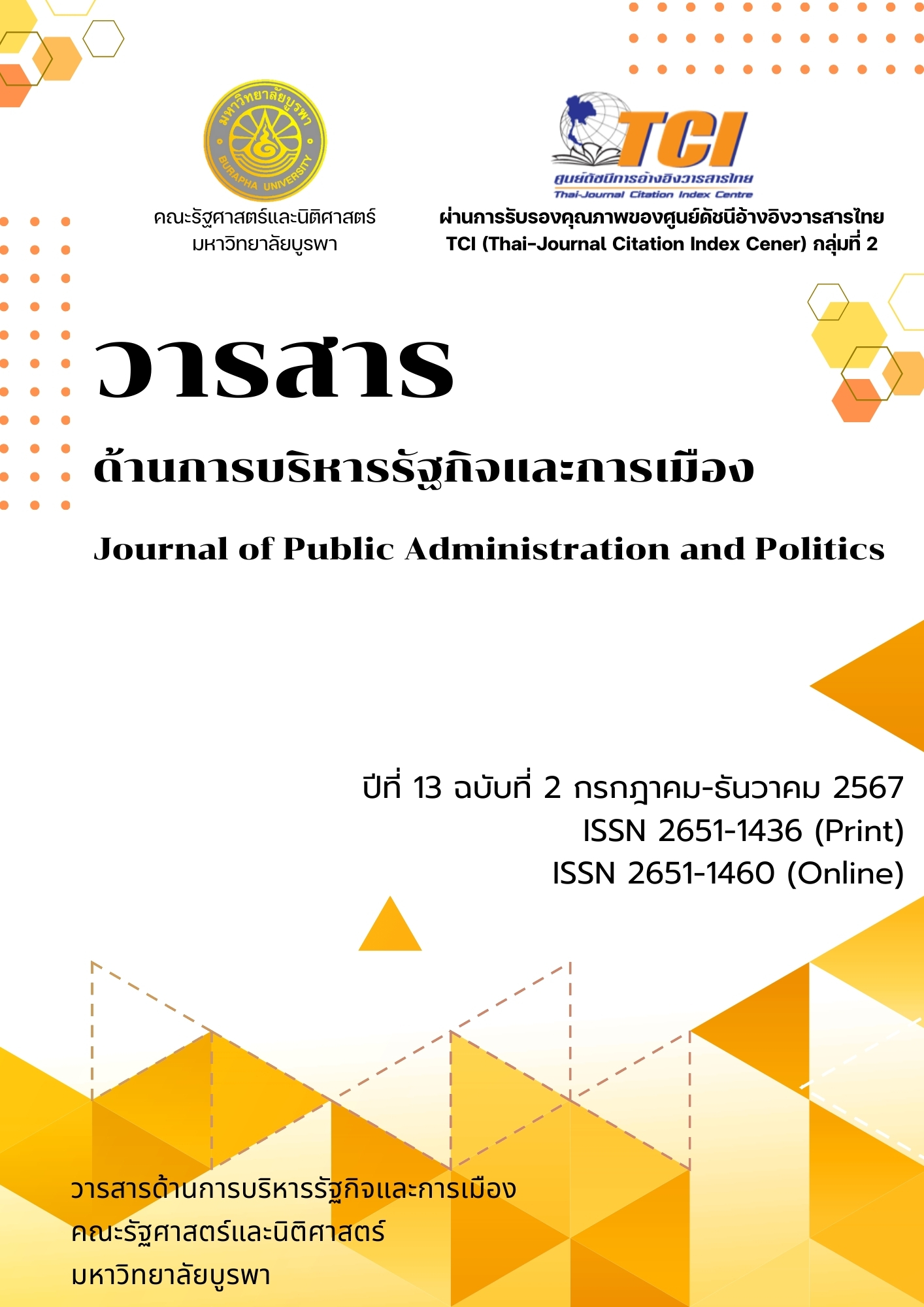แนวทางสหวิทยาการสำหรับการพัฒนานโยบายผู้สูงอายุ
Main Article Content
บทคัดย่อ
บทความวิชาการนี้มีวัตถุประสงค์เพื่อ 1) เข้าใจการศึกษานโยบายผู้สูงอายุตามแนวทาง สหสาขาวิชา 2) สำรวจมุมมองสาขาต่าง ๆ ต่อการศึกษานโยบายสาธารณะ เช่น สาขาวิชาวิทยาการว่าด้วยผู้สูงอายุสาธารณสุข สังคมวิทยา เศรษฐศาสตร์ จิตวิทยา และรัฐประศาสนศาสตร์ 3) ปัญหาอุปสรรคการศึกษานโยบายผู้สูงอายุตามแนวทางสหวิทยาการ และ 4) แนวทางในการส่งเสริมการศึกษาเรื่องผู้สูงอายุตามแนวทางสหวิทยาการ การศึกษาพบว่า 1) การทำงานร่วมกันข้ามสาขาวิชาและการบูรณาการมุมมองจากหลายสาขานั้นเป็นการสร้างความเข้าใจที่ครอบคลุมและเป็นรากฐานที่แข็งแรงสำหรับการพัฒนานโยบายที่มีประสิทธิผลและมีคุณภาพสำหรับผู้สูงอายุในสังคมในระยะยาว 2) สาขาที่ศึกษานโยบายสาธารณะ เช่น สาขาพฤฒาวิทยาเป็นการศึกษาเกี่ยวกับการสูงอายุที่ให้ข้อมูลที่ลึกซึ้งในแง่มุมต่าง ๆ เกี่ยวกับผลกระทบของการสูงอายุต่อบุคคล ครอบครัว ชุมชน และสังคม 3) ปัญหาอุปสรรคที่ทำให้การศึกษาตามแนวทาง สหวิทยาการไม่ก้าวหน้าเท่าที่ควรในการพัฒนาและการดำเนินนโยบายผู้สูงอายุ อุปสรรคสำคัญที่ขัดขวางการทำงานร่วมกันอย่างมีประสิทธิผลระหว่างผู้เชี่ยวชาญจากหลากหลายสาขา เช่น ความแตกต่างในมุมมอง อุปสรรคในการสื่อสาร ข้อจำกัดด้านทรัพยากร และ 4) การใช้แนวทางสหวิทยาการในการพัฒนานโยบายผู้สูงอายุนี้ยังเป็นวิธีการที่มีประสิทธิภาพในการจัดการกับความซับซ้อนและความหลากหลายของผู้สูงอายุและนำไปสู่พัฒนานโยบายที่เหมาะสมสำหรับผู้สูงอายุในอนาคต
Article Details
เอกสารอ้างอิง
ภาษาไทย
สมบัติ ธำรงธัญวงศ์. (2559). สหวิทยาการเพื่อการวิจัยและพัฒนากับมุมมองในการพัฒนาการเมือง. วารสารราชภัฏสุราษฎร์ธานี, 3(1), 35-48.
ภาษาอังกฤษ
Antonucci, T. C., & Akiyama, H. (2019). Social networks in aging societies: Elderly people in Japan and the United States. Berlin: Springer.
Bengtson, V. L., & Settersten, R. A. (Eds.). (2016). Handbook of theories of aging. New York: Springer Publishing Company.
Berkman, L. F., Kawachi, I., & Glymour, M. M. (2014). Social epidemiology. Oxford, United Kingdom: Oxford University Press.
Binstock, R. H., & George, L. K. (Eds.). (2018). Handbook of aging and the social sciences. Cambridge, Massachusetts, USA.: Academic Press.
Boyd, C. M., Fortin, M., & Future of Primary Care Working Group. (2012). Future of multimorbidity research: How should understanding of multimorbidity inform health system design?. Public Health Reviews, 32(2), 451-474.
Estes, C. L., & Binney, E. A. (2016). The biopsychosocial perspective and social policy: The state of knowledge and methods of inquiry. In Handbook of Social Gerontology (pp. 107-127). Berlin: Springer.
Hebert, R., Brayne, C., & Spiegelhalter, D. (2013). Incidence of dementia in the oldest old: the 3-City study. Neurology, 80(15), 1371-1378.
Hooyman, N. R., & Kiyak, H. A. (2011). Social gerontology: A multidisciplinary perspective. Boston, Massachusetts: Pearson Education.
Institute of Medicine. (2008). Retooling for an Aging America: Building the Health Care Workforce. Washington, D.C.: National Academies Press.
Johnson, R. W. (2011). The economic impact of aging populations. Cheltenham: Edward Elgar Publishing.
Johnson, S., & Sossin, L. (Eds.). (2017). Aging + Communication + Technologies: Connecting the Generations. Abingdon, United Kingdom: Routledge.
Kerstetter, W. A., & Connelly, T. W. (Eds.). (2014). Aging in the 21st Century: A Developmental Perspective. Berlin: Springer.
Klein, J. T. (2008). Evaluation of interdisciplinary and transdisciplinary research: A literature review. American Journal of Preventive Medicine, 35(2), S116-S123.
Knickman, J. R., & Snell, E. K. (2002). The 2030 problem: Caring for aging baby boomers. Health Services Research, 37(4), 849-884.
Lee, R., & Mason, A. (2011). Population aging and the generational economy: A global perspective. Cheltenham: Edward Elgar Publishing.
Levy, B. R. (2009). Stereotype embodiment: A psychosocial approach to aging. Current Directions in Psychological Science, 18(6), 332-336.
Marengoni, A., Angleman, S., Melis, R., Mangialasche, F., Karp, A., Garmen, A., ... & Fratiglioni, L. (2011). Aging with multimorbidity: A systematic review of the literature. Ageing Research Reviews, 10(4), 430-439.
Masoro, E. J., & Austad, S. N. (2010). Handbook of the biology of aging. Cambridge, Massachusetts: Academic Press.
Minkler, M., & Fuller-Thomson, E. (Eds.). (2005). Interdisciplinary perspectives on aging in the era of globalization. London: Routledge.
National Academies of Sciences, Engineering, and Medicine. (2016). Accounting for social risk factors in Medicare payment. Washington, D.C.: National Academies Press.
O’Rand, A. M., & Henretta, J. C. (2011). Age and inequality: Diverse pathways through later life. London: Routledge.
Petersen, R. C., Lopez, O., Armstrong, M. J., Getchius, T. S., Ganguli, M., Gloss, D., ... & Sager, M. A. (2016). Practice guideline update summary: Mild cognitive impairment: Report of the Guideline Development, Dissemination, and Implementation Subcommittee of the American Academy of Neurology. Neurology, 90(3), 126-135.
Repko, A. F. (2012). Interdisciplinary research: Process and theory. California, USA: Sage Publications.
Rice, D. P., Fineman, N., & Miller, L. S. (2011). Economic implications of increased longevity in the United States. Annual Review of Public Health, 32, 35-56.
Schafer, M. H., & Mousaid, S. (2019). Older workers, new jobs? Employment prospects and policies for an aging labor force in the US and Germany. Journal of Aging & Social Policy, 31(1), 57-78.
Schaie, K. W., & Willis, S. L. (Eds.). (2010). Handbook of the psychology of aging. Cambridge, Massachusetts: Academic Press.
Wang, L., & Hsiao, Y. (2019). Older adults’ volunteering and well-being: A study of a volunteer-friendly community. Journal of Applied Gerontology, 38(10), 1445-1470.
Wenger, G. C. (2016). The global aging preparedness index. Journals of Gerontology Series B: Psychological Sciences and Social Sciences, 71(2), 205-214.
World Health Organization. (2007). Global age-friendly cities: A guide. Geneva, Switzerland: World Health Organization.


